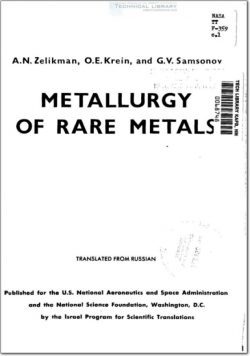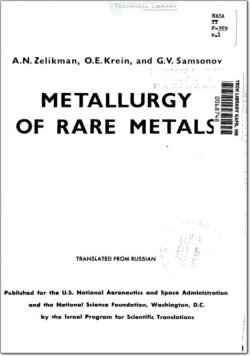NASA-TT-F-359C.1

- Version
- 161 Downloads
- 32.23 MB File Size
- 1 File Count
- August 18, 2016 Create Date
- August 18, 2016 Last Updated
Metallurgy of Rare Metals

At the beginning of the 20th century, certain chemical elements found
important industrial applications for the first time. This group of elements
is known as ”rare elements" or, in a more narrow sense, "rare metals”.
As may be seen in Table 1 (in which the rare metals appear in bold—
face frames) the "rare metals" group comprises metals in all groups of
the periodic table. Their physicochemical properties are accordingly
very different, and the rare metals group comprises those metals which
for a number of reasons have only recently found commercial use.
The main reason for it is that most rare metals were only discovered
at the end of the 18th and in the 19th centuries. At the same time, their
scarcity and the fact that many of the rare metals are widely dispersed
over the Earth's crust, as well as the difficulties encountered in the
extraction and purification of some of them, also interfered with their
industrial utilization.
Table 2 (compiled by Academicians V. I. Vernadskii and A. E. Fersman)
shows the use of chemical elements by man, in various historical periods.
The use of all metals in the "rare metals" group dates from the 19th and
20th centuries.
Thus, the concept "rare metal" originally referred to metals which had
little or no technological use. In our own time, however, many rare
metals are extensively used in modern technology. The very existence of
a number of branches of technology would be unthinkable without the use
of rare metals. Of the 70 metals (listed in Table 3) in production at the
present time, forty—one belong to the rare—metals groups. Thus, the
"rare-metals" group is not a scientific classification but has a historical
meaning.
It is a common error to associate the term 'rare metal" with a low
abundance of the element in nature. To correct this misconception, we
shall give some recent data on the abundance of elements in the Earth's
crust. Proceeding from analytical data, geochemists calculated the
composition of the Earth's crust, down to a depth of 16km. The first
tables showing the composition of the Earth's crust were compiled in 1889
by the American scientist F. Clark. Their accuracy was subsequently
improved.
| File | Action |
|---|---|
| NASA-TT-F-359C.1 Metallurgy of Rare Metals.pdf | Download |
Comment On This Post